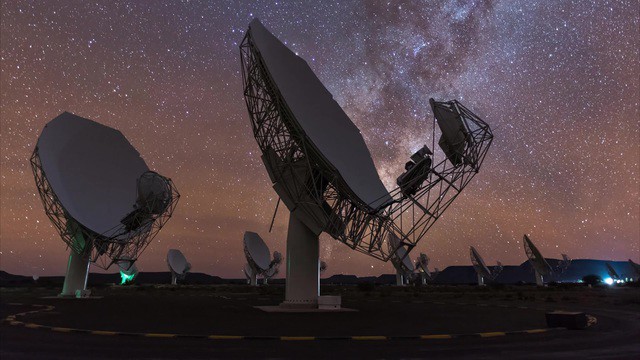Monster structure discovered that could contain 30 Milky Ways
(NLDO) - The MeerKAT radio telescope in South Africa has just discovered Inkathazo, a representative of a group of extremely large but elusive 'cosmic monsters'.
According to Science Alert, Inkathazo is a giant radio galaxy, a group of monster structures in the universe, with many unusual characteristics and difficult to detect.
According to astrophysicist Kathleen Charlton (University of Cape Town - South Africa), co-author of the study on Inkathazo, the name of this giant galaxy means "trouble" in isiZulu and isiXhosa, the indigenous languages of South Africa.
That's because understanding the physics behind what's going on with these types of hyper-objects is incredibly difficult.

The MeerKAT radio telescope, a network of 64 antenna dishes in South Africa, has identified the "space monster" Inkathazo - Photo: SOUTH AFRICAN RADIO ASTRONOMY
Radio galaxies have had physical properties that have puzzled scientists, with supermassive black holes accreting matter at the galactic core and emitting giant jets of plasma that glow at radio frequencies.
Galaxies larger than about 2 million light-years across can be classified as giant radio galaxies, or GRGs.
According to the research team, the "monster" Inkathazo has a diameter of up to 3 million light years, enough to trap 30 of our Milky Way galaxies.
In addition, it also reveals some unusual features compared to other giant radio galaxies.
For example, the plasma jets have an unusual shape: Instead of extending straight from one end to the other, one of the jets is curved.
Additionally, Inkathazo lies in the middle of another galaxy cluster, where conditions would prevent the development of such giant jets.
In hopes of unraveling the mysteries of Inkathazo, the researchers used MeerKAT to create high-resolution spectral age maps of the galaxy, which could reveal the age of the plasma in different regions inside the monster.
This map shows anomalies in Inkathazo's jets, where something mysteriously powers some of the electrons.
This may reflect the impact of the wider cosmic neighborhood, the authors say.
Instead of shooting its plasma into relatively empty space, Inkathazo's jets erupt into the intergalactic voids in its galaxy cluster, where their interactions with hot gases could explain the strange energy surge.
'These findings challenge existing models and show that we still have much to learn about the complex plasma physics at play in these extreme galaxies,' the authors write in Monthly Notices of the Royal Astronomical Society.
You should read it
- It turns out this is how the galaxy Milky Way formed 13.5 billion years ago
- Detecting UGC 2885, a giant spiral galaxy, 2.5 times larger than the Milky Way galaxy
- The largest-ever explosion in the universe created a giant hot-air sphere that could hold 15 Milky Way galaxies
- Astronomers discovered a 'candy cane' in the center of the Milky Way
- Revealing new findings about the size of the galaxy
- The mysterious bubble that appears in the center of the Milky Way galaxy is finally 'decoded'.
- The discovery of a giant black hole, 70 times the mass of the Sun in the Milky Way, challenges every theory
- 9 amazing facts about the universe amaze you
- Science has discovered the fastest-flying star in the Milky Way, reaching 8% of the speed of light
- The facts about the universe amaze you
- Galaxy merger moment gives glimpse into Milky Way's future
- The galaxy containing Earth has a 'second heart', which is 13 billion years old
Maybe you are interested
15 traditional customs during the traditional Vietnamese New Year Release the free tool to kill ZBot malware How to fix C: windowssystem32configsystemprofiledesktop Is Unavailable on Windows 10 Open all file formats with a single software Top 5 free game development software tools 4 free online tools to add text to videos
